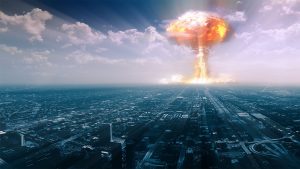Anyone who shakes their head over the insanity of US President Donald Trump’s threatened “fire and fury” against nuclear-armed North Korea might want to take a look at a rather dry paper in the Massachusetts Institute Technology journal International Security.
The paper is titled “Revisiting Hiroshima in Iran.” Academics Scott Sagan and Benjamin Valentino examine the United States’ so-called nuclear taboo, which is supposed to have created an ethical norm for the use of nuclear weapons after the horrors of Hiroshima and Nagasaki. They address the strength of the taboo and the supposed rise of a humanitarian spirit that makes Americans squeamish about killing large numbers of non-combatant foreigners. They look at the proclivities of 21st-century Americans using a hypothetical scenario that revolves around a war started by non-nuclear-armed Iran.
The results of the survey experiments can only be described as chilling. When a representative sample of the US public was asked about a situation that approximately replicated 1945 and substituted Iran for Japan, “a clear majority of Americans (56%) would approve of using nuclear weapons first against the civilian population of a non-nuclear-armed adversary, killing 2 million Iranian civilians, if they believed that such use would save the lives of 20,000 US soldiers.”
So Trump is not the only American willing to rain “fire and fury” — vague intimation of a nuclear holocaust — on a foreign land. The findings cannot be attributed to the Trump effect, some sort of public coarsening as the result of being led for six months by a man given to provocative brawler statements, because the Sagan-Valentino survey was conducted two years ago. At the time, a Pew poll indicated that 76% of American respondents said they held very or somewhat unfavourable opinions of Iran.
While this is just one study, there are three reasons to take it seriously: Who conducted it? How? Where did the analysis appear?
Working backward, the analysis appeared in a publication that is among the world’s most definitive peer-reviewed journals on US national security policy and international affairs.
How the survey experiments were conducted is essential to the strength of the conclusions. The researchers did not use random sampling and telephone polling but a relatively new, more accurate academic survey method, which was administered by the polling firm YouGov. The design of the survey experiments was meant to ascertain the response to potential first use of nuclear weapons against a country about which Americans had negative feelings.
Respondents were given mock news articles that laid out the escalating conflict — severe US sanctions on Iran because it had violated terms of the 2015 nuclear deal; an Iranian attack on a US aircraft carrier killing 2,403 military personnel (the same number as in the Pearl Harbour attack, though that was not mentioned in the story); retaliatory US air strikes that destroyed Iran’s nuclear infrastructure, air defences and planes; Iran’s refusal to surrender and the resulting US ground invasion, which sees 10,000 US military fatalities after several months of fighting.
Respondents were offered the two options available to the US president to end the war: Fight on and capture Tehran or drop a nuclear weapon on Mashhad, Iran’s second-largest city.
That the respondents chose the latter led the researchers to conclude “there has been relatively little change in US public opinion about using nuclear weapons or killing non-combatants since 1945.”
The study has been well-received by experts, including King’s College War Studies’ Emeritus Professor Lawrence Freedman and Stephen Schwartz of the Middlebury Institute of International Studies. This is mostly on account of the researchers’ credentials. Sagan, a professor at Stanford, is an acknowledged expert on nuclear proliferation and weapons’ safety. Valentino, who coordinates the war and peace studies programme at Dartmouth, specialises in genocide and foreign policy.
Their conclusions are inescapable. Unlike post-second world war Germany, post-Hiroshima America doesn’t seem to care too much about the tragic lessons of the past. Once upon a time, successive polls appeared to show Americans as rather sickened by the knowledge their country had dropped atomic bombs on a faraway land. For 70 years after Hiroshima and Nagasaki, the prevailing consensus revolved around an American moral repulsion to the bomb.
In fact, Thomas Schelling, the late US Nobel economics laureate who is credited with creating the concept of a Cold War peace, celebrated the “nearly universal revulsion against nuclear weapons” in a 2005 speech.
But Sagan and Valentino have demonstrated this is not the case at all. They have shown that a 21st-century rerun of the 1945 countdown to bombing foreign cities would elicit broad American public approval.
Existing polls did not ask Americans to choose between foreign civilians and US troops and to do so with nuclear weapons as the game changer. This survey did and it ascertained that Americans picked their own side to save. This is probably not unusual for any people, except for the high cost of using nuclear weapons. Shouldn’t the United States, the world’s most powerful country, be more mindful of the ethical limits of its power? In an international crisis, shouldn’t the world expect the American people to serve, in Sagan and Valentino’s words, as a “constraint” rather than a “goad” to nuclear weapons’ use?
The dismal answer is there for all to reflect on.


